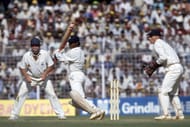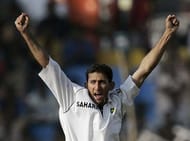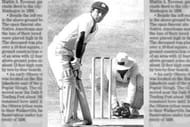Cricket is such an overwhelmingly large beast. It is so incredibly large that it is a wonder most fans haven’t taken a moment to think about the scale of operations.There is organised cricket in all corners of the world, in all formats of the game, at any given time – to say nothing of informal games in the gullies of the subcontinent or the beaches of Australia. International, county, state, school level – you name it, there’ll be something going on.In such a saturated environment, only the most noteworthy performances stand out and are remembered in the years to come. Fans remember India’s memorable win at Port-of-Spain in 1971, but often forget Jack Noreiga took 9/95 in India’s first innings in only his second Test.It does not come as a surprise, then, that many significant milestones are reached in unusual circumstances. They may have been quietly accumulated over a period of time, or have remained standing for several years.They may take the form of surprising statistical validation for some, or of cricketing stories for others to tell their children and grandchildren. Here are five such facts.
#1 Vinod Kambli has a higher Test average than Sachin Tendulkar

Yes, who would have thought it? After initially coming to prominence following a world record stand of 664 runs in the Harris Shield in 1988, Sachin Tendulkar and Vinod Kambli seemed destined for greatness.
It was all incredibly exciting. Tendulkar debuted for the national side the following year, scarcely old enough to vote or drink alcohol (...legally), and Kambli followed in 1993.
Their close friendship was well known and circumstance ensured the public didn’t forget about it in a hurry; one was often at the opposite end of the pitch when the other reached a personal milestone.
Vinod Kambli enjoyed a sensational start to his career, but the euphoria didn’t last long. He crashed and burned spectacularly – never the same after Courtney Walsh and his soldiers mercilessly exposed his weakness against the short ball in late 1994 – a little short of two years after his Test debut. He featured only sparingly thereafter.
Kambli’s later career was besieged by controversy and his exit was anything but glorious. If one did not know the whole story, they would no doubt have wondered why a scorer of two consecutive triple hundreds did not receive a better farewell.
Kambli, though, can claim his due. He may have played 183 Tests fewer but Kambli boasts a Test average of 54.2 while Tendulkar mustered 53.78. Kambli even has a better first class average: 59.67 versus 57.84.
#2 Ajit Agarkar is the fastest Indian to 50, 150, 200 and 250 ODI wickets

Remember Ajit Agarkar? For a few years after the new millennium, it looked as though Indian cricket had finally found their bits-and-bobs man. There were several talented players in the side, but none who could match Agarkar’s unique blend – that of useful batting, aggressive bowling and a never-say-die attitude.
For a few years, he was the go-to man when India needed a handy cameo, but then it all went very sour very quickly. For despite a fairly encouraging 2005-06, Agarkar was dropped like a bad habit.
The marriage had ended badly; the wife was unceremoniously divorced when the romance was lost, and the ex-husband gleefully scurried off after his new mistresses: Sreesanth and Ishant Sharma.
There had been better days. Agarkar, unbelievably, is still the quickest Indian to 50, 150, 200 and 250 ODI wickets. He was the quickest to 50 wickets in his day, and is the second quickest (with Mitch McClenaghan) to 50 wickets outright; although Ajantha Mendis took fewer matches (19 versus 23), Agarkar got his fifty in almost exactly six months.
Agarkar is also the third most prolific wicket taker for India in ODIs with 288 scalps – behind Anil Kumble and Javagal Srinath but ahead of Zaheer Khan and Harbhajan Singh. What makes this feat especially noteworthy is that Agarkar played fewer games than all four – just 191.
#3 Wasim Akram hit the most sixes in a Test innings

No, you read that wrong. He didn’t get hit for the most sixes. He hit the most sixes.
More than Chris Gayle, more than Adam Gilchrist, more than even Brendon McCullum managed in an innings.
It is an astounding feat the more you think about it. Wasim Akram’s highest Test score, an undefeated 257 against Zimbabwe in Sheikhupura in 1996, gives him a remarkable position in the hierarchy of high scorers.
It was great innings too. With the scoreboard reading a shaky 183/6, Akram walked out with the sole aim of preventing concession of a significant lead for Zimbabwe. It turned out to be much better than that.
The tail provided admirable support as Akram decided to chance his arm in order to get on top of the bowling.
The ploy worked. 34 balls were smashed to the rope, the 12 record breaking sixes among them, and the hundred came from a towering six off Andrew Whittall over long on – Akram’s first since Adelaide in 1990, with Pakistan in a similar mess.
Incredibly, Akram’s innings meant Pakistan were well placed to make a mad dash for victory. In that they were unsuccessful, with Zimbabwe refusing to give in, finishing the Test on 241/7.
Captain Akram could hardly have complained however. Besides collecting the man of the match award, he also led Pakistan to a 10 wicket win in the next Test, claiming the series.
#4 Ian Bell is England\'s highest run scorer in ODIs

One day cricket is all about seizing that one moment. A window of opportunity that shuts without warning. And which once shut, remains shut. The time is limited, the attention span of spectators even more so. You need big scores to grab their attention. And unless you bat in one position at the top of the order, you often won’t get those big scores.
A bit surprising, then, that Ian Bell is England’s highest run getter in ODIs. He’s an unobtrusive sort of chap who has been shuttled up and down the order with nonchalant frequency. Quite the antithesis of the character that usually succeeds at white ball cricket.
Even so, Bell’s 5416 career runs place him comfortably above any other Englishmen in one day cricket. This includes the effervescent Kevin Pietersen – Bell is almost a thousand runs better off.
Perhaps it is something about the one day side that brings the best out of the unassuming breed: next on the list after Bell is England’s favourite Man Friday Paul Collingwood.
#5 Sunil Gavaskar once batted left handed for an hour

Sunil Gavaskar rose to the top of the sport by dint of his classical defensive elegance at the top of the order. And obduracy, for that matter, since he knew there was a real danger Malcolm Marshall might knock his head off at any moment.
It was one of his most ingenious plans, however, that worked exactly like he had hoped, but made him a lightning rod for criticism at the same time.
March 1982. The second Ranji Trophy semi final was played at Bangalore between Karnataka and Mumbai.
Mumbai batted first and put on 271. A Karnataka side containing Roger Binny, Syed Kirmani and captain Gundappa Vishwanath responded superbly, and took a 199-run lead.
Concession of such a huge lead more or less killed Mumbai’s hopes of progressing to the final; they began their second innings reasonably well but there wasn’t much to fight for.
A solid opening partnership was followed by complete disintegration of the Mumbai batting line up. One by one the batsmen were sent back to the pavilion with their tail between their legs as left arm spinner Raghuram Bhat ran riot.
An innings defeat was now looking a real possibility even as Gavaskar walked in at a shocking number eight in the order. The ball was going left and right all over the place and Gavaskar, who later said he had ‘zero chance’ against Bhat, realised desperate times called for desperate measures.
He switched to batting left handed in an attempt to hold Raghuram Bhat at an arm’s length to ensure Mumbai didn’t have to taste defeat. Batting like this for one hour, Gavaskar notched 18 from 66 balls to carry Mumbai to 200 for 9.
They dodged outright defeat, but Karnataka advanced to the final on the basis of their first innings lead.
Bhat was quite charitable in his assessment of Gavaskar’s batting the aftermath of the match. Of course, since his team had made the final, he could afford to be.
And after all that, with Gavaskar facing a critical mauling for his actions, Karnataka lost that final to Delhi despite scoring in excess of 700 runs in their first innings.
Follow IPL Auction 2025 Live Updates, News & Biddings at Sportskeeda. Get the fastest updates on Mega-Auction and cricket news
